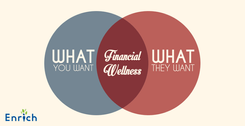Related Posts
Employers and Organizations
5 Strategies to Increase Financial Wellness Program Participation
Last Update: October 17, 2015
Photo Courtesy of: Miles Heller
The choice to invest in your employee’s financial wellness is one that will affect your company’s growth—by lowering employee financial stress, lowering health insurance premiums, and increasing productivity.
The results far exceed the investment, leading to an extremely high ROI.
Add to that the necessity of having to plan for retirement and it’s clear that Financial Wellness is more important now than it has ever been.
Providing employees with financial education is only the first step to building a reliable and productive workforce—the next step is getting employees to participate in the program.
Here are 5 strategies you can use to make the most out of your investment—strategies that will boost program participation, increase access, simplify use and maximize engagement.
1. Incentives Increase Participation
Incentives are a great start and they are not bribes!
They are meant to encourage simple behaviors, where intention can be converted into action.
Research in behavioral psychology, behavioral finance, and wellness programs show that incentives work best when participants are starting or on-boarding a program.
Incentives can be monetary or non-monetary.
Access to learning opportunities (such as exclusive conferences, workshops or summer programs) or t-shirts can work just as well or better than cash and gift cards.
By leveraging an online learning management system (LMS) like Enrich’s financial wellness platform, incentives can be tied to specific actions such as signing up, creating a personalized profile, completing certain recommendations, and exploring relevant features (such as budget tracking).
According to a recent survey conducted by Mercer Global, a global consultation firm, 56% of large employers use incentives in their wellness initiatives. In 2014, in another Mercer study, large employers using incentive programs reported higher participation rates.
2. Stop Asking for Permission: Switch to Opt-Out Strategies
Opt-out strategies standardize financial wellness and ensure that every employee has access to resources.
Coupled with an effective communication plan and meaningful incentives to start, providing the choice to “opt-out” ensures that employees are aware of the availability and benefits of participating in a Financial Wellness Program.
Organizations have successfully used opt-out strategies in benefits programs, 401k programs and campus wellness (such as gym membership and mental health services).
According to a presentation at The Future of Financial Wellness for the Stanford Center on Longevity by Dr. David Kaplan, automatic enrollment in a 401k plan increased participation from 59% to 86% and “helps people save sooner—for those 6 months on the job, participation went from 34% to 90%.”
3. Commitment Contracts:
Commitment contracts are a cross-disciplinary strategy that has been shown to work on two levels: 1.) As a prompt to complete agreed-upon behavior and 2.) as a way to set a goal, place something at stake, and use what’s at stake to be held accountable.
Employers have a number of resources outside of financial wellness that they can leverage in order to maximize the impact of a commitment contract.
The goal for these contracts is not to punish employees but to set personal expectations and create meaningful consequences for completing them.
In his paper, Exploring the Impact of Learning Contracts on Student Commitment and Academic Performance, Timothy Frank proposed that “solidifying the commitment on paper may have been the difference between good intentions and action,” after seeing 78% of students on contract improve their grades versus 59% without.
4. Personalized Goal Setting
Personalized goal setting is a way for employees to measure progress based on what they accomplish.
This strategy has been employed across a variety of organizations and purposes. Individualized education plans are used in public education for high-achieving or low-achieving students.
Personal weight loss goals are most effective when tailored to a person’s level of activity, nutrition and body.
Personal goals work when they are attainable, and feedback is meaningful when it can be used to adjust behavior—showing employees when they are excelling or when they have more work to do.
Financial Wellness Programs lend themselves to this type of goal setting and achievement, as progress metrics and recommended content comes packaged in their services.
5. Make it Fun! Programs, contents, etc.
Joy is one of the most powerful known motivators, and it is experienced through different kinds of interaction.
Based on several key motivational theories, joy can be brought on through competition, belonging, curiosity, learning and mastery among other sources.
Group reward programs and contests can be used to support engagement around financial Wellness Programs or on application of financial concepts. Users can be evaluated based on reporting features or on completing specific content.
Doorways to Dreams--a non-profit organization that provides financial products and education services for low and moderate income consumers—started a Save to Win program in Michigan where each $25 deposit enters users into annual and monthly contests to win up to $250 a month.
Employers now face the challenge of engaging their employees in a meaningful way to best equip them with the skills they need to lead successful professional and financial lives.
Though there is no one-size-fits-all approach to increasing employee use of financial wellness programs, segments of the population can be targeted using a strategy that appeals to them the most.
To see how the Enrich Financial Wellness Program is configured to include these best practices, check out our demo video.
Featured Posts

Employers and Organizations
3 MIN
10 Simple Ways Benefits Managers Can Recession-Proof Their Employee Benefits Package

Employers and Organizations
3 MIN
3 Reasons to Make After-Tax Contributions to Your Retirement Plan

Employers and Organizations
4 MIN
Financial Information vs Employee Behavior Change: Which Is More Important for Your Company’s Financial Wellness Program?

Employers and Organizations
3 MIN
Does Your Employee Financial Wellness Program Take Mindset Into Consideration?
Related Posts

Employers and Organizations
5 MIN
Providing Incentives for Your Employee Financial Wellness Program

Employers and Organizations
2 MIN
Why Employees Disengage From Wellness Programs

Employers and Organizations
4 MIN
What Are The 3 Keys to Financial Health?
